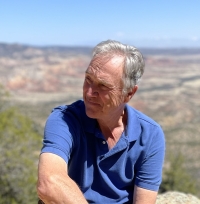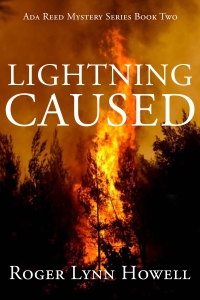Author's Notes: Ada Reed and the Yankee Fork
When I worked in the Yankee Fork forty years ago, I camped with my friends in the old townsite of Custer. From there we hiked out daily to map the geology of the surrounding hills and to work out the mineralogy of the mining district. There were no tourists then, just us and a half dozen old codgers still winning a little color from the rocks. The Sunbeam store, five miles downriver, sold cold beer, and you could get a fine steak at Torrey’s Hole down on Highway 75. For dancing and over-drinking, we’d head to Stanley and Casanova Jack’s Rod and Gun Club.
The miles of tailings behind the dredge had not yet been smoothed and re-contoured for fish passage, and the road up the Yankee Fork was not nearly so wide and accomodating. The Yankee Fork dredge floated in its pond, not yet kid-proofed and commissioned as an attraction. It was inaccessible—it might even have been posted No Trespassing (I admit no recollection of that). But one evening after a visit to the Sunbeam store, one of our crew bet that he could leap the six feet from shore to the first bucket without getting wet. He couldn’t, but I could, and we and a couple others climbed the bucket line to the top, then clambered down into the guts of that river monster.
In dim light through dirt-streaked windows, we balanced along beams, ducked under struts, and climbed onto high catwalks. Cobbles sat on the beltline and sand lay in the riffles of the shaker table just as they’d been left when the engines shut down and the men walked away a generation earlier. We found boots and slickers and shift report books, and notes scribbled on office walls by long-extinct foremen and engineers.
We talked little, and we took nothing, not even photos. But I’ve never forgotten the feel or even the smell of that Ozymandian place nor the sense of a world and a time before my own inhabited by fathers and hardy aunts and uncles—tall people with tall tales of how life once was lived.
I’ve tried to put a little of that sense into Ada’s story. And it is just that: a story. It is pure fiction, and any resemblance to happenings or to tall people living or dead is pure coincidence.
In this book again, I have not respected geography. Custer actually sits a mile farther upstream than I, for convenience, put it. I deleted Bonanza altogether, and Camas… well, most of you will know what town’s name I’ve changed. And yes, you and I know the main road up the canyon was not designated Highway 75 back in 1951. It was called U.S. 93 until 1977, and the current U.S. 93 was designated Alt-93. But imagine the spitting and fussing if I tried to stick to those historical particulars.
Anyway, that’s all just detail. I have been true to the geology, and as ever, that is what matters.
Author's Notes: The Magpies' Song and the Pahsimeroi Valley
First of all, this story has absolutely nothing to do with Andy, Deb, Hart, Carl, Bruce, Jim, Ellie, Dave, Susan (who stuck with me), Lorie, nor even that old storyteller Dan. But it has everything to do with old friends in a special time and place. So, here’s to all of you. We came to know the Salmon River country together and knew it when we were at our best—when the hills were not as tall nor the days so short, and the roads were dry and uncrowded. We had fishing, love, and beer, and who gave a damn then if it was the River of No Return?
Anyway, it’s all still there if you’re ever back in east-central Idaho: the tall grasses and cool riparian forests, the afternoon sun on your neck, and the magpie chatter. That country has always called to me, and not just because I stomped around there in the years after college when I was flush with youth, and friendship, and beer.
It is an open country but inward looking. Tolerant of strangers for the most part, the people are uninterested in your personal business and unlikely to bother you that the road is troubled ahead. But if you get stuck, as you likely will, they’ll sigh, shake their heads, and get out their tow chains.
The town I write about, Fort Quittence, does not really exist. The valley does, although I have embellished quite a bit to make it more habitable than God ever bothered to. In truth I have taken bits and pieces of many different valleys and rivers and small western towns in order to create Fort Quittence, and I’ve peopled the valley with a lot of folks I knew well and a few I probably didn’t.
Still, for all that fabrication the sun really does poke between the Lemhi (LEM-high) peaks to burn off the morning mist. And it slips golden behind the Lost River Range then hastens back to where it arose when nights are short and summery. The Pahsimeroi (p’-SIM-uh-roy) River slides east out of the high country then flows north—but hardly as the dangerous torrent I describe. The Little Lost River is even more of a disappointment, being barely a bull wallow for most of its length. Still, it flows west out of the Lemhis before turning south to its ignoble end beneath the lavas of the Snake River Plain.
And between those headwaters June, Dana, Carl, and Bash sit on a top rail and watch the horses kick and the magpies take wing.
Author's Notes: The Reclamation - Central Idaho
Stibnite Idaho may be the most remote town of any size in the lower forty-eight. It lies fifteen miles up an awful dirt road from Yellowpine. Yellowpine is another sixty miles of dirt from McCall, which is no great shakes itself but is paved. Cinnabar is five miles more remote than Stibnite, but it no longer counts as a town.
The mineral deposits of Cinnabar and Stibnite were discovered in the 1800s. For nearly a century the district lolled in obscurity, with just a few shallow scratchings to support the unhurried hill people who lived there. The Second World War lifted the towns from their slumber, sometimes with a boot.
The district was put under the charge of the U.S. War Production Board. The Army was desperate for mercury, tungsten, and antimony, and those strategic metals gave Cinnabar and Stibnite first pick of the best miners and equipment in the country. Still, I’m told, to have walked the streets or drink in the taverns then you might never have understood that these towns were at war. Nothing but the faintest notion of the crusade ever penetrated so deeply into Idaho, over the dusty miles of pine forest, through the layers of granite stacked up around the district.
My own father did, in fact, sign on with the mine recruiters, and he brought with him to Cinnabar my mother, JoAnne, and my sister, Helen. If my mother’s heart sank at the sight of wall tents lining half the muddy main street of Stibnite, she may fairly have wept when she topped the ridge and looked down upon the rough-wood and tarpaper shacks of dark Cinnabar. Or she might have been relieved, finally, to be home with her child and the man she loved. When she and I hiked back into Cinnabar years ago, we did not speak of those things.
It is important to note that The Reclamation is not meant to be a chronicle of any sort. I have interwoven memories of Cinnabar and other mining camps I’ve lived and worked in, and I’ve not been careful with geography, nor with history, nor with the layout of roads and businesses. If I’ve included family anecdotes—my mother trapping martens in the winter woods and working a sluice for gold—these accounts end well short of biography. JoAnne and the fictional Jolene were both barely educated women who yearned to be more, and who pushed themselves to read and explore. You use what you know to flesh out what you would invent. For the record I was not born in Cinnabar, nor did any of my family die there. And for the record, all of the characters and events in this story are fictional.

.png)
